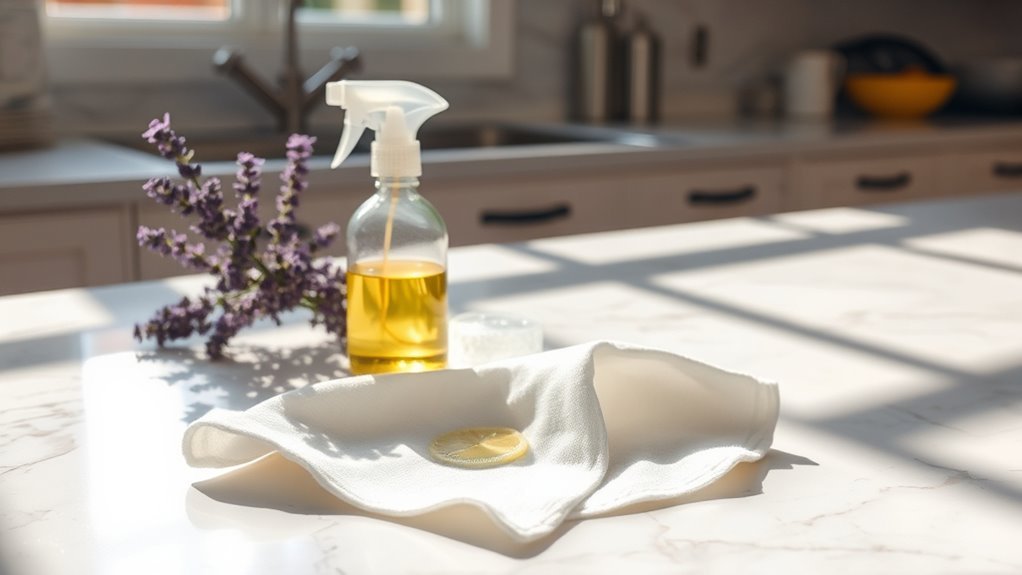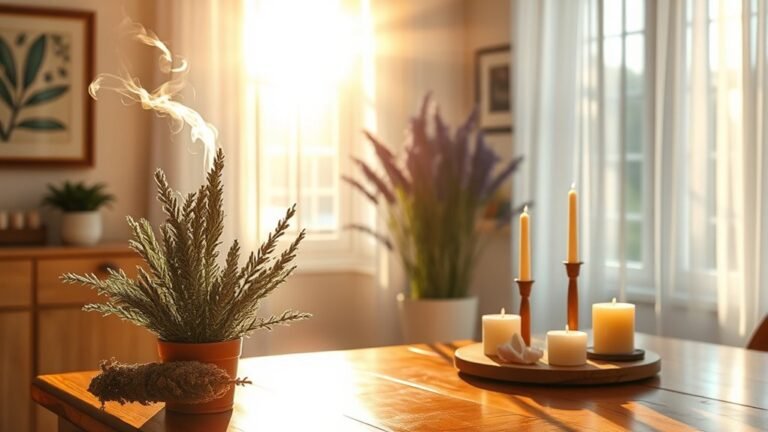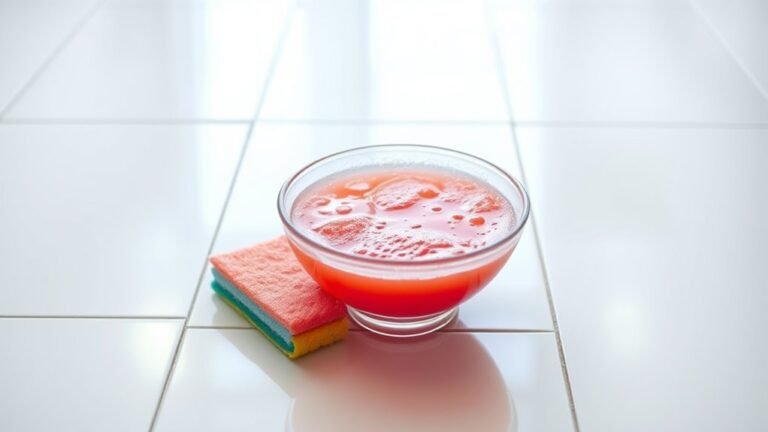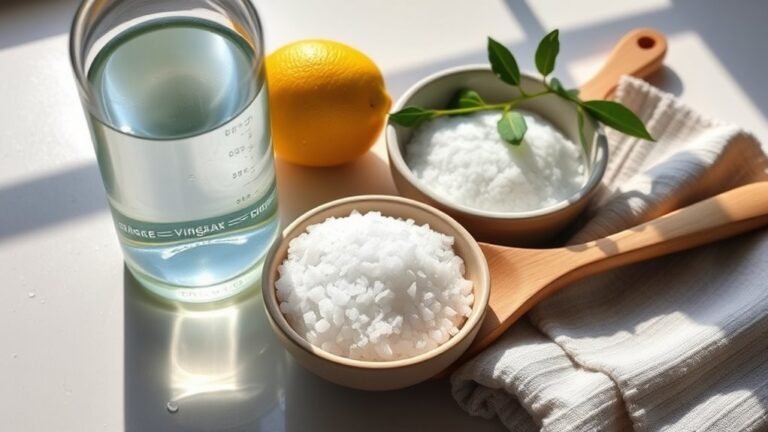Using Essential Oils to Clean Stains
You can use essential oils to clean stains by mixing 10-15 drops with water, vinegar, or rubbing alcohol, then applying it gently to the affected area. Oils like tea tree, lavender, lemon, and eucalyptus dissolve oils, fight bacteria, and freshen fabrics naturally without harsh chemicals. Remember to test first on a hidden spot to avoid damage. This simple, eco-friendly method not only cleans but also protects your health and environment. Keep exploring to discover more ways these oils work wonders.
How Essential Oils Work on Stains
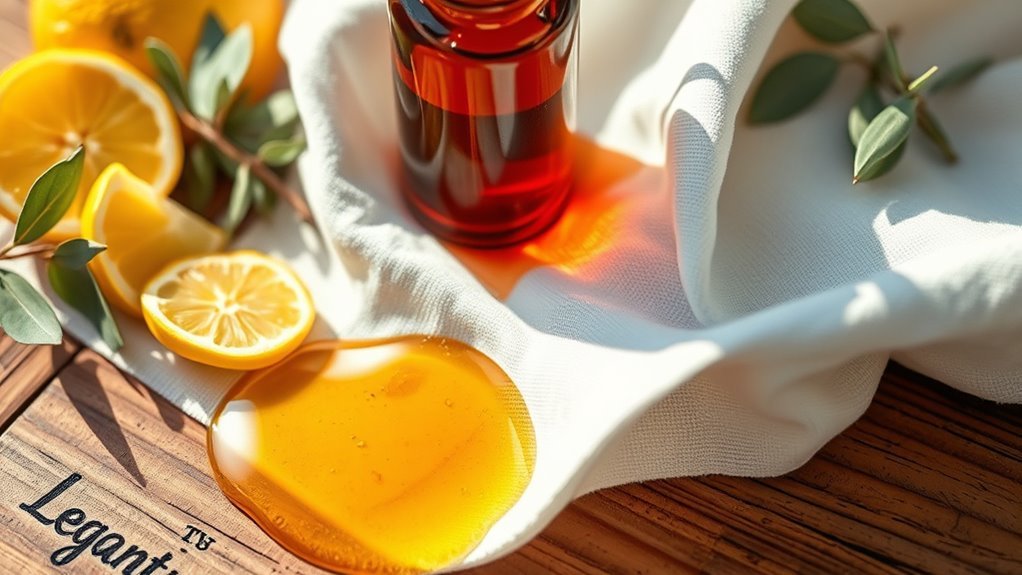
Essential oils break down stains by targeting the oils and dirt that cause them. When you understand essential oils chemistry, you realize these natural compounds have molecules that interact directly with stain particles. Their stain removal mechanisms involve dissolving the oily substances and loosening dirt, making it easier to lift stains from fabrics or surfaces. You don’t need harsh chemicals to regain control over your space; essential oils offer a cleaner, freer way to tackle messes. The way these oils penetrate and break down stains means you can rely on them to handle stubborn spots without compromising your health or environment. Knowing how essential oils work empowers you to embrace a more liberated, natural approach to stain removal.
Top Essential Oils for Stain Removal
There are several powerful oils you can turn to when tackling stains, each with unique properties that make them effective cleaners. Lavender oil is a top choice because it not only fights bacteria but also has a gentle scent that won’t overwhelm your space. Its natural antiseptic qualities help break down stubborn spots, giving you a fresh and clean result. Tea tree oil is another must-have—it’s known for its strong antimicrobial and antifungal properties, making it especially useful on organic stains like mold or mildew. Using these oils lets you clean with confidence and freedom from harsh chemicals. By choosing lavender oil and tea tree oil, you’re embracing a natural, effective way to keep your home spotless while enjoying the power of nature’s own cleaners.
Preparing Essential Oil Cleaning Solutions
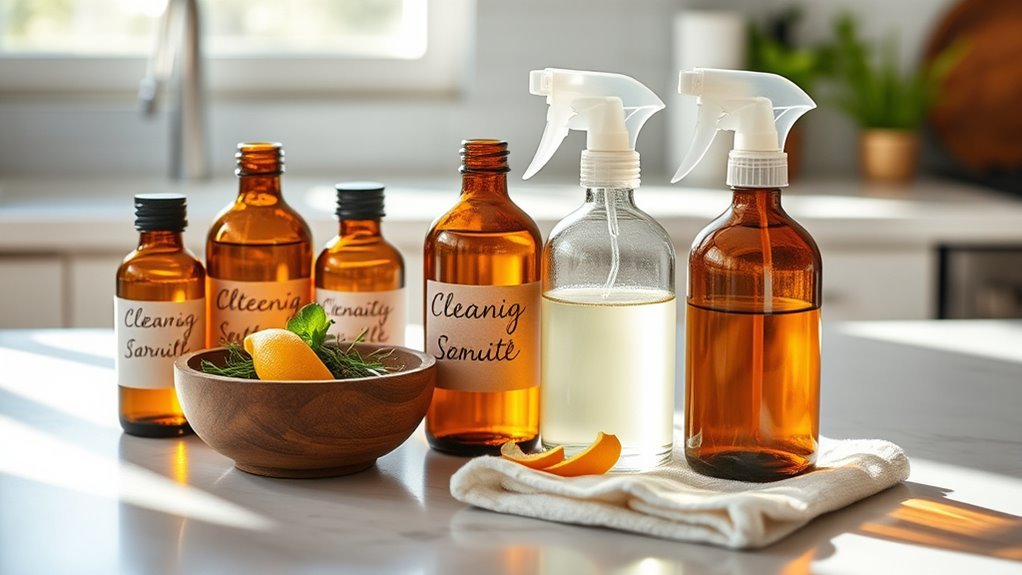
Now that you know which oils work best for stain removal, it’s time to learn how to prepare effective cleaning solutions. Creating your own essential oil blends gives you the freedom to tailor your DIY cleaning products to your needs. Here’s a simple guide to get you started:
Discover how to craft personalized essential oil blends for powerful, natural stain removal solutions.
- Choose a carrier liquid like water, vinegar, or rubbing alcohol based on the stain type.
- Add 10-15 drops of your preferred essential oils into 1 cup of the carrier.
- Mix the solution well in a spray bottle or jar for easy application.
- Label your blend and test it on a small, hidden area before full use.
Using Essential Oils on Fabric Stains
You’ll find essential oils not only add a fresh scent but also offer natural antibacterial and stain-fighting properties for your fabrics. Applying them correctly can boost your stain removal results without harsh chemicals. Let’s explore simple techniques to use essential oils effectively on fabric stains.
Essential Oils Benefits
Although essential oils are often praised for their pleasant aromas, their benefits go far beyond scent, especially when it comes to tackling fabric stains. When you choose essential oils, you’re opting for a natural, eco friendly solution that respects your freedom to avoid harsh chemicals. Their aromatic properties not only freshen fabrics but also help break down stubborn stains. Here’s why they’re a smart choice:
- Natural stain-fighting agents that work without damaging fabric fibers.
- Antibacterial qualities that help sanitize your clothes during cleaning.
- Biodegradable and safe for the environment, supporting sustainable living.
- Versatile options allowing you to customize scents and cleaning power.
Application Techniques
When treating fabric stains with essential oils, it’s important to apply them correctly to maximize their effectiveness without damaging the material. Start by diluting the essential oil with a carrier like water or white vinegar—this helps prevent any harsh effects on delicate fabrics. You can use application methods such as a spray bottle for even coverage or a cotton ball for targeted stain treatment. Gently dab the stained area instead of rubbing, which can push the stain deeper. Let the essential oil mixture sit for 10-15 minutes before rinsing or laundering as usual. Remember, testing on a small, hidden fabric patch first guarantees the oil won’t cause discoloration. With the right application techniques, you can confidently tackle stains while preserving your fabric’s integrity.
Cleaning Stains From Hard Surfaces With Essential Oils
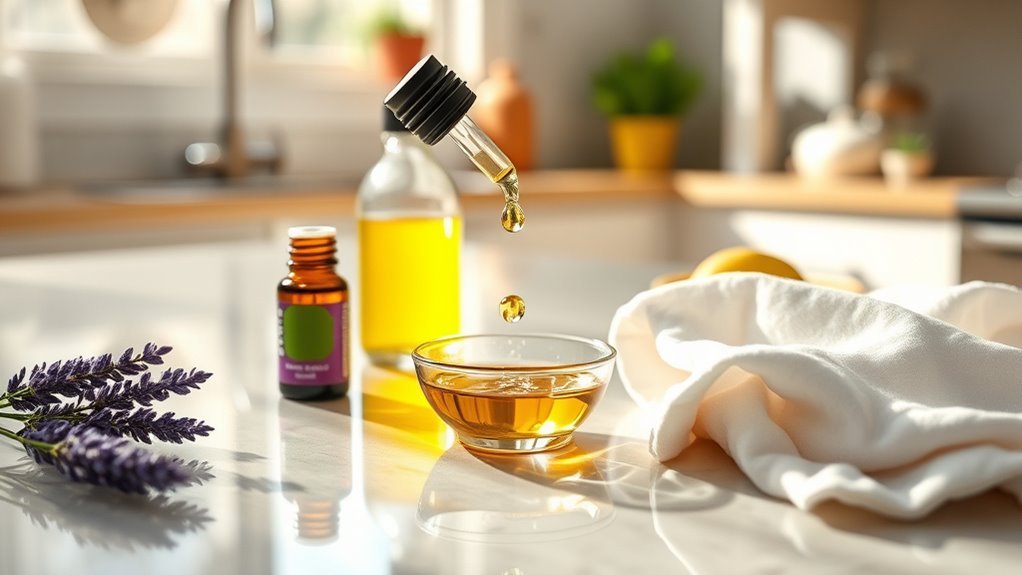
When tackling stains on hard surfaces, certain essential oils like lemon, tea tree, and eucalyptus work best for their natural cleaning power. You’ll want to apply them carefully, often diluted with water or combined with a gentle scrub, to avoid damage. Let’s explore some tips and tricks to get the most effective and safe results.
Best Oils for Stains
Since hard surfaces often show stains more clearly, choosing the right essential oil can make your cleaning efforts much more effective. Different stain types call for oils with specific properties to break down grime without damaging surfaces. Here are the best oils to weigh:
- Tea Tree Oil – Antimicrobial properties tackle mold and mildew stains.
- Lemon Oil – Natural degreaser perfect for oily or sticky residues.
- Eucalyptus Oil – Strong solvent action helps lift ink or dye stains.
- Lavender Oil – Gentle disinfectant ideal for light surface stains and freshening.
Application Tips and Tricks
Choosing the right oil is just the start; knowing how to apply it effectively makes all the difference in removing stains from hard surfaces. Different stain types, like grease or ink, require tailored application methods. For oily stains, mix essential oils with a gentle carrier like vinegar or baking soda to boost cleaning power. Apply the blend directly onto the stain using a cotton ball or spray bottle, then let it sit briefly before wiping. For tougher stains, gently scrub with a soft brush to loosen residue without damaging surfaces. Always test oils on a small area first to avoid discoloration. With these tips, you’re free to tackle stains confidently, harnessing nature’s power without harsh chemicals. Precision in application guarantees your hard surfaces stay spotless and fresh.
Safety Tips When Using Essential Oils for Cleaning
Although essential oils offer natural cleaning benefits, you’ll want to handle them carefully to avoid skin irritation, allergic reactions, or damage to surfaces. Taking these safety precautions guarantees your cleaning routine stays effective and safe.
- Always dilute essential oils with a carrier like water or vinegar to reduce skin sensitivity.
- Test a small area first to check for allergic reactions or surface damage.
- Wear gloves to protect your skin, especially if you have sensitive skin or allergies.
- Keep essential oils away from children and pets, as some oils can be toxic if ingested or applied improperly.
Combining Essential Oils With Other Natural Cleaners
To get the most out of your cleaning routine, you can blend essential oils with other natural cleaners like vinegar, baking soda, or lemon juice. These essential oil blends enhance the power of natural cleaning, tackling stains and odors effectively without harsh chemicals. For instance, adding tea tree or eucalyptus oil to a vinegar solution boosts its antimicrobial properties, while lemon oil combined with baking soda creates a revitalizing, stain-lifting paste. You’ll enjoy a cleaner home and the freedom of safe, eco-friendly ingredients. Just remember to test mixtures on small areas first to avoid damage. By experimenting with these combinations, you’re crafting personalized, potent natural cleaning solutions that align perfectly with your lifestyle and values.
Benefits of Using Essential Oils Over Conventional Stain Removers
While conventional stain removers might promise quick results, essential oils offer a safer and more natural alternative that’s gentle on your fabrics and the environment. Choosing essential oils means you’re embracing freedom from harsh chemicals with added perks. Here’s why you might want to switch:
- Reduced environmental impact – essential oils biodegrade easily, unlike many synthetic chemicals.
- Health benefits – they’re less likely to cause skin irritation or respiratory issues.
- Multipurpose use – beyond stain removal, they freshen and disinfect naturally.
- Cost-effective – a little goes a long way, saving you money over time.
Frequently Asked Questions
Can Essential Oils Damage Delicate Fabrics?
Yes, essential oils can sometimes damage delicate fabric types if you’re not careful. Since essential oils are concentrated, they might cause discoloration or weaken fibers, especially on silks or wools. You’ll want to do a small stain testing patch on an inconspicuous area before applying oils widely. This way, you’re free to enjoy their benefits without risking your favorite clothes. Always dilute oils properly and handle delicate fabrics with extra care.
How Long Do Essential Oil Cleaning Solutions Last?
Did you know essential oil cleaning solutions have a shelf life of about six months? To keep yours fresh and effective, store them in a cool, dark place away from sunlight and heat. You’ll want to use airtight containers to prevent oxidation. By following these storage tips, you maintain freedom from waste and guarantee your solutions stay potent, ready whenever you need a natural, powerful clean without hassle or chemicals.
Are Essential Oils Safe for Pets During Cleaning?
You’ll want to be cautious with pet safety when using essential oils for cleaning. Not all essential oil types are safe around your furry friends—some can cause irritation or worse. Always research which oils are pet-friendly, like lavender or chamomile, and avoid toxic ones such as tea tree or eucalyptus. Keep your pets out of the area during and after cleaning to guarantee they stay safe while you enjoy a fresh, natural environment.
Can Essential Oils Remove Old, Set-In Stains?
When it comes to old, set-in stains, you’ll find that essential oil combinations can boost stain removal effectiveness, but they might not work miracles alone. You’ll want to mix oils like lemon and tea tree with natural cleaners for better results. Keep in mind, stubborn stains often need a bit of elbow grease or multiple treatments. Essential oils give you a natural boost, but freedom means knowing when to combine methods for the best clean.
Do Essential Oils Leave a Scent After Cleaning?
You’ll find that essential oils often leave a subtle scent after cleaning, thanks to their oil potency. The scent longevity can vary depending on the type and amount you use—some oils like lavender or eucalyptus have a stronger, lasting aroma, while others fade quickly. If you love freedom from harsh chemicals and want a natural fragrance, essential oils offer that revitalizing, gentle scent without overwhelming your space.
